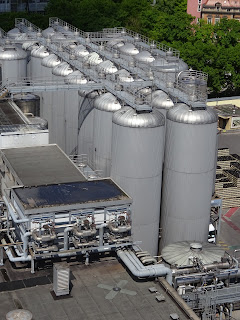This was in the entrance:
And there's a portrait of him upstairs:
His copied British malting techniques to make paler malts from which he made the first amber coloured lager.
Today the brewery produces the Löwenbräu and Franziskaner brands as well as Spaten. Annual production is 3 million hl, 60% wheat beer and 40% lager.
We were shown round a brewhouse, proudly displayed to the road outside by large windows, though it's not actually been used since 2006. The copper is made from old 1950s vessels and is used to clad stainless steel ones from the late 80s/early 90s.
10 tonnes of malt are used for each batch, giving a brew length of 800-900 hl. The lagers are mashed in at 60°C and the temperature is stepped up to 78°C, presumably with a couple of rests along the way.
Next door to the copper clad brew house were some rather less pretty vessels and there were no big display windows in this room! Hop pellets and extract are used during the one hour boil in a Jetstar wort boiler with an internal calandria and slight over pressure. Slaked lime and ion exchange is used to treat the brewing liquor before addition of calcium chloride and a lactic culture goes in the mash and kettle. It's particularly important for the alcohol free beers and the wort is acidified to pH 4.8-4.9.
The hot wort is filtered with perlite (60g/hl). Horizontal tanks are used for the lagers and CCVs for the wheat beers. The wheat beers are mashed in at 37°C, then stepped up to 44°C and 62°. And though it's not in my notes probably 78°C for mashing out.
The filters are pretty substantial:
For PVPP a leaf filter is used, and a candle filter for kieselguhr filtration.
There are 34 fermenting vessels of 3400hl, holding 4 brews. Weiss beer is fermented for three days at 21°C and is bottled two weeks after brewing. The yeast count is lowered to two to three hundred thousand cells per ml by centrifugation and lager yeast is added as it settles better.
The bottling hall has three different lines, rated at 40, 50 and 60 thousand bottles per hour, which is all the more impressive when you see that they use recycled bottles. There were five to seven staff per line: perhaps one person on bottle washer, one on crate filler, one on palletiser, one on bottle filler, one on labeller and maybe other looking at conveyors and quality. The didn't want us taking pictures of that so you'll have to take my word for it. Kegging is carried out at a rate of 500 kegs per hour.
We also got to have a look in the cellars which date from 1848-9. They had the world's first artificial cooling in 1873, though the machine only worked for three days before breaking!
 |
| Personally I'm more alle macht den räten |
The cellars have holes in the roof where ice as dropped in:
And there is a museum in the cellars:
Where a bottling dalek can be seen:
As well as the old tat often found in historic breweries:
After the cellars we moved up in the world for a pork and lard based lunch and great views of Munich and the tank farm:
For those that care about the distinction between the bourgeoisie and the petite bourgeoisie this brewery was definitely not craft, but at no time did I think the people working there were any less passionate about brewing as any other brewers we met.
























Confused about the purpose of the lactic culture in the mash and kettle. Surely it isn't in the mash long enough to do very much, and will be killed in the kettle?
ReplyDeleteYou're right the bugs won't have a chance to do anything in the brew, but by having a separate tank where lactic fermentation can take place in advance the brewery can in effect add lactic acid to lower the pH whilst staying within the bounds of the reinheitsgebot. Lost and Grounded use this method: http://lostandgrounded.co.uk/2017/02/the-heart-of-our-brewery-a-7hl-lactic-acid-tank/
Delete